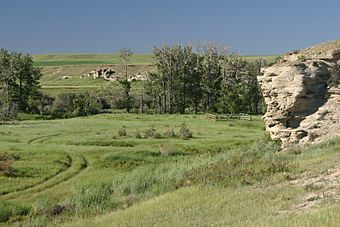Camp Disappointment facts for kids
|
Camp Disappointment
|
|

Camp Disappointment, 2005, view northeast from south bluff. Camp site marked by fenced-in historical marker. Cottonwood trees in background line the banks of Cut Bank Creek. The ledge to the right was an Indian buffalo jump.
|
|
| Nearest city | Browning, Montana |
|---|---|
| Built | 1806 |
| NRHP reference No. | 66000434 |
Quick facts for kids Significant dates |
|
| Added to NRHP | October 15, 1966 |
| Designated NHL | May 23, 1966 |
Camp Disappointment is a very important historical site in Montana. It was the northernmost camp of the famous Lewis and Clark Expedition. This expedition explored the western United States.
The camp is located on private land. It is part of the Blackfeet Indian Reservation. You can find it along the south bank of Cut Bank Creek. It is about 12 miles (19 km) northeast of Browning, Montana. From the camp, you can even see Glacier National Park far away.
Contents
Camp Disappointment: A Historic Stop
This campsite was used by a small group from the Lewis and Clark expedition. They stayed there from July 22 to July 26, 1806. Captain Meriwether Lewis led this group. Other members included George Drouillard and the brothers Joseph and Reubin Fields. There might have been five more men and six horses.
Why the Name "Disappointment"?
The group was exploring the Marias River. They hoped to prove that the Missouri River's water system reached far north. They wanted it to reach the 50th parallel. This would help the United States claim more land from the Louisiana Purchase.
However, they found that the river system did not go that far north. Because of this discovery, they named their camp "Camp Disappointment." Captain Lewis described the area as a "beautiful and extensive bottom." It was shaded by large cottonwood trees.
The weather was cloudy and wet during their stay. This meant they could not make any important sky observations. This group had separated from William Clark's main party. They split up at the Great Falls of the Missouri on July 16.
An Important Meeting
On the morning of July 26, 1806, the group left Camp Disappointment. Later that day, they met eight Blackfeet Indians. This was the first time the expedition had met members of this tribe.
The Blackfeet seemed friendly at first. Both groups agreed to set up camp together for the night. During the evening, the Blackfeet learned something important. They found out that Lewis and Clark had been trading with other tribes. They had also helped make peace between tribes. Many of these tribes were enemies of the Blackfeet.
The Blackfeet were especially upset about the trade of firearms. Guns were very rare and valuable at that time. The Blackfeet had been trying to control the gun trade themselves.
After everyone went to sleep, the Blackfeet tried to take the expedition's guns. One of Lewis's men woke up during the attempt. This alerted the others. The situation quickly turned into a fight. Two Blackfeet men were shot and killed. The expedition members felt it was necessary for self-defense.
This conflict happened near the Two Medicine River. It is now known as the Two Medicine Fight. This was the only time during the entire Lewis and Clark expedition that they had a violent encounter with Native Americans.
Remembering the Expedition
In 1925, the Great Northern Railway put up a monument. It looks a bit like the Washington Monument. There is also a sign about 4 miles (6.4 km) south of the campsite. This is near mile marker 233 and U.S. Route 2.
You can reach the campsite by a simple dirt road. It is just west of this marker. In 1966, Camp Disappointment was named a National Historic Landmark. It was also added to the National Register of Historic Places.
Visiting the Site Today
The area around Camp Disappointment looks much like it did in 1806. It is on private land, but you can visit it. There is an admission fee, and you will need a 4-wheel drive vehicle.
The site also has an ancient Indian buffalo jump. A buffalo jump was a cliff where Native Americans would herd buffalo. The buffalo would then fall off the cliff. This provided a lot of food and hides for the people.
Today, wide, grassy areas are watered by Cut Bank Creek. Cottonwood trees grow along its banks. From the high plains, you can see the creek's path. Dark green trees mark its course towards the mountains.
Right next to the camp is a large stone cliff. It is about 300 feet (91 m) high and 600 feet (183 m) wide. This very steep cliff was a buffalo jump. It is in good condition because of its quiet location. The creek at the bottom of the cliff has uncovered many bones. These are from the buffalo that fell from the cliff long ago.



